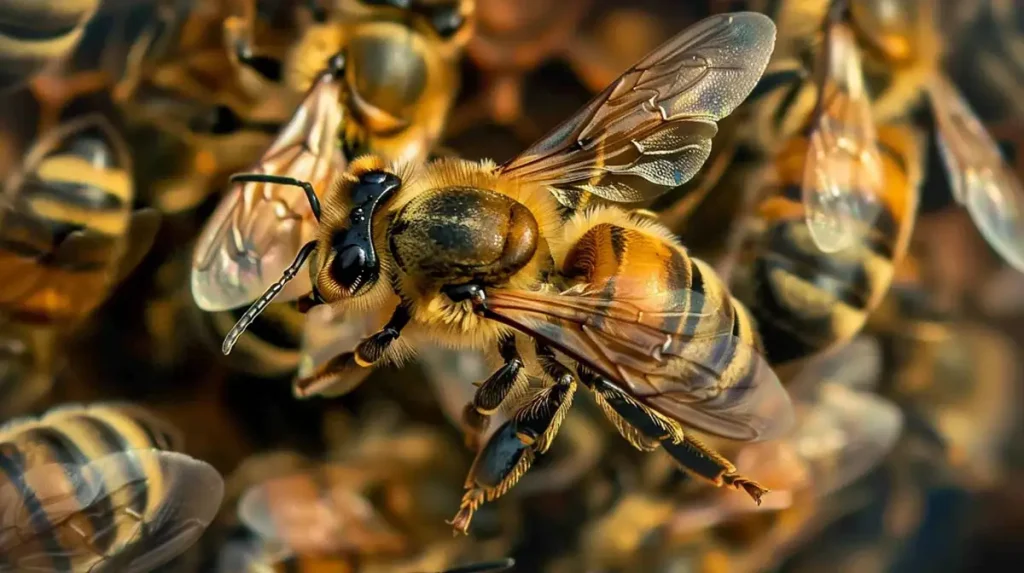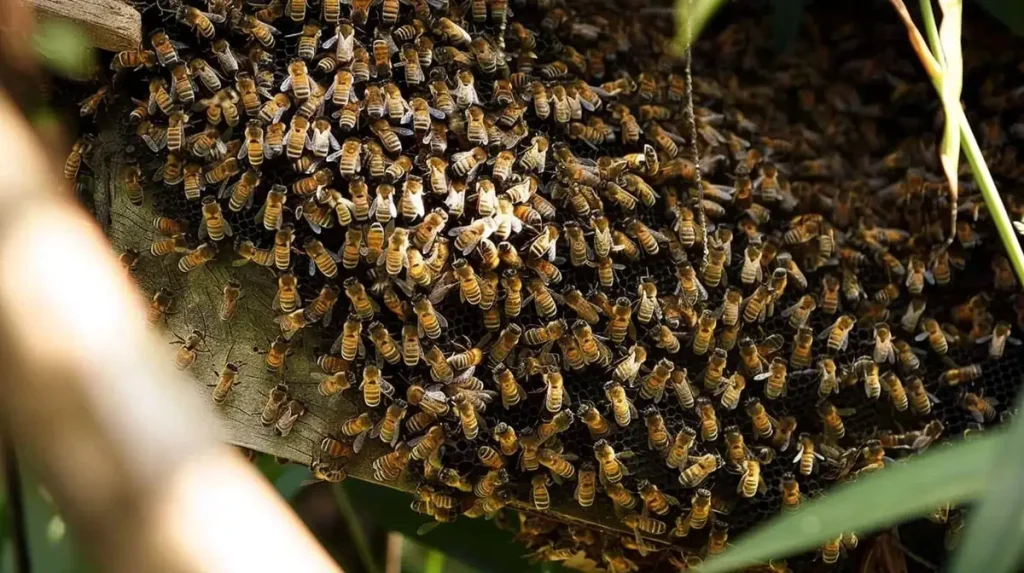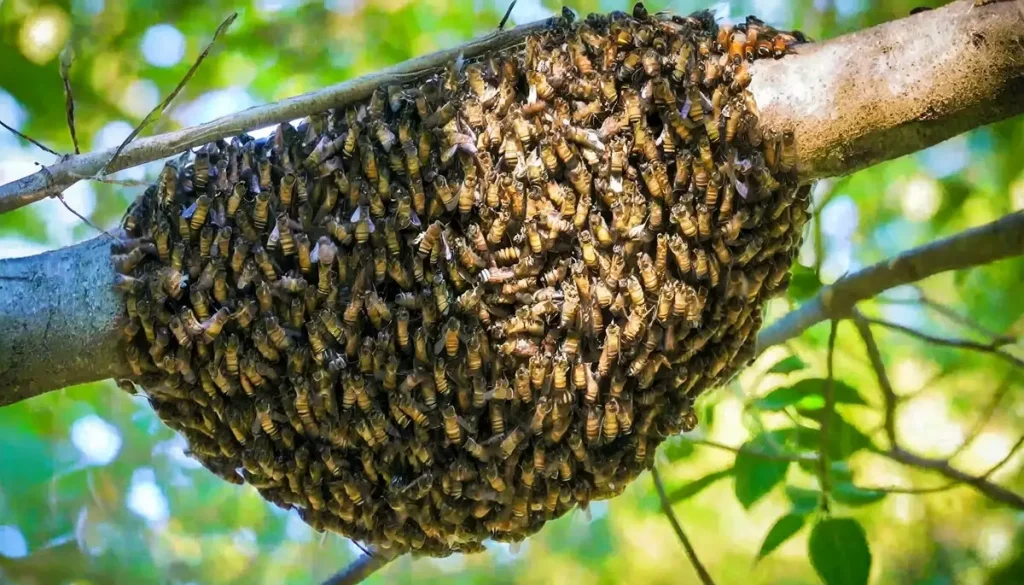Table of Contents
Beekeeping’s popularity has grown as more people become interested in sustainability and the benefits of natural products like honey. However, starting a beekeeping operation can be costly with expenses ranging from equipment like hives and tools to the bees themselves. But what if there was a way to obtain bees without having to purchase them? Enter catching a swarm of bees. Swarms occur naturally when a colony of bees splits in two and the bees form a cluster around their queen as they search for a new home. While catching a swarm can save beekeepers money, it can also be a daunting task for newbies. In this article I will explain what to do after catching a swarm of bees, including how to house and care for them and what steps to take to ensure their health and productivity.
Catching a Swarm of Bees
Swarming in bees tend to occur either because the hive has become overcrowded, in which case a colony tends to split into two, or because the conditions in the hive have become unbearable for whatever reason so the entire colony leaves to find a new home.
If you spot a swarm of bees, you might be lucky enough to have the chance to capture them. Some swarms settle on low branches while sending out scouts to look for a new home, making the entire process of capturing a swarm easier. Nevertheless, some swarms might decide to stay up high in the branches, in which case it is obviously dangerous to try a capture as you could harm yourself in any number of ways.
If it is deemed safe enough to attempt a capture, you will need a suitable container for the bees. This could be a hive, a large bucket, or even a box. If you are lucky enough to have found a swarm on a low, rather thin tree branch, you could cut the branch from the tree and place it into your container (make sure you are wearing your suit when trying to catch a swarm!).
If the branch of the tree is either too thick to cut or too big to fit into your container, you could try to “scoop” the bees from the branch and place them into the container. Or you could even try shaking the branch over your container.
The queen is highly likely to be in the middle of the swarm, so you will need to try your best to ensure she is placed into the container sooner rather than later. The reason is that once she is in the other bees will likely follow. You will know she is in the container once the bees stop returning to the branch.

After Catching the Swarm
Once the swarm has been placed into the container, you will need to move it to its new, permanent home. Before you do this though you will need to wait until the scouts have returned. As mentioned above, swarms will have sent out scout bees to search for a new home. They are unlikely to return until around dusk.
The move to their new home should take place once the sun has set as this is when the bees are far less likely to leave the hive. If you have used a box or bucket to catch the swarm, you will need to move it to a hive or a nucleus (a small hive that can hold around five frames). It is best to move them to their permanent hive as soon as possible.
When moving the bees, you will need to be as gentle as possible so as not to disturb them too much. After all, the swarm will not have any reason not to abscond until the queen has started laying in the new hive. If you disturb them too much, they may just up and leave to find a new home.
If you have any spare brood from another hive, you can add it to the new hive to give the bees a reason to stay. If not, it might be worthwhile placing a queen excluder in front of the hive entrance as the bees will not leave the hive without the queen. You should leave the excluder there for a few days. Once you notice the bees carrying pollen back to the hive, you can safely remove it as this is a sign that the bees have settled and made the hive their new home.
You should make sure to feed the new swarm as this will help to sustain them while they build new comb. Bees will need a lot of energy to build the new comb, so feeding them initially will give them a much-needed boost. Some beekeepers feed a new swarm sugar water while others provide frames will honey.

When Should You Inspect the New Hive?
When it comes to inspecting a new hive, timing is crucial to ensure the success of your beekeeping venture. Inspecting too soon after moving the bees can be detrimental to the hive as it may cause stress and disturbance to the bees. This can lead to absconding. Therefore, it is important to wait for the right time to inspect the hive.
- Carter, Anthony (Author)
- English (Publication Language)
- 194 Pages - 02/28/2024 (Publication Date) - Independently published (Publisher)
Most beekeepers recommend waiting at least a week before inspecting the new hive. During this time, the bees will have had a chance to settle down and start building comb. Additionally, the queen will have started laying brood, which is a sign that the bees have accepted their new home. By waiting for this period, you ensure that the bees are invested in their new surroundings and are less likely to abscond when disturbed.
It is essential to understand that the timing of the inspection will also depend on the weather conditions. In cooler weather the bees will be less active and less likely to become agitated, which makes it a more suitable time to inspect the hive. Conversely, during warmer weather the bees will be more active and may become agitated if disturbed, making it a less suitable time for inspection.
Before inspecting the hive, you need to ensure that you have all the necessary equipment, including a bee suit, gloves, smoker, hive tool, and brush. It is also important to approach the hive calmly and slowly as sudden movements and loud noises can trigger the bees to become defensive.
To summarize the inspection of a new hive, the timing of the inspection is critical to the success of the whole endeavor. Waiting for at least a week after moving the bees and choosing the right weather conditions are essential in minimizing the risk of absconding while ensuring a smooth transition for the bees into their new home.
What to Do After Catching a Swarm of Bees – Conclusion
Caught a swarm of bees, now what? Catching a swarm of bees can be an exhilarating and rewarding experience for any beekeeper. However, it is crucial to approach the situation with caution and care to ensure the safety of both the bees and beekeeper. Once the swarm has been successfully caught it is important to transfer them to a hive as soon as possible. This will not only provide the bees with a stable and secure home but it will also prevent them from leaving in search of a more suitable location.
After transferring the bees to their new hive, it is crucial that you provide them with the necessary resources to thrive. This includes food, water, and ample space for the colony to grow. Regular inspection and monitoring of the new colony is also essential to ensure their health and prevent any potential issues arising.
It is important to remember that bees play a vital role in our ecosystem and as beekeepers we have a responsibility to ensure their well-being. By following the appropriate steps and being mindful of the needs of the bees we can successfully establish a new colony and continue to contribute to the important role that honey bees play in our environment.
Looking to up your beekeeping game? Check out our latest product recommendations so you can take things to the next level!
Introducing The Top 12 Best Beekeeping Veils For 2024
Introducing The Top 20 Best Beekeeping Gloves For 2024
Introducing The Absolute Best Beekeeping Suits For 2024
The 15 Top Beekeeping Books for 2024
The Top 11 Honey Extractors for 2024
The Top 12 Mason Bee Houses for 2024
Beekeeping Disclaimer:
Beekeeping, like any agricultural activity, involves inherent risks. It is important to understand these risks and take appropriate measures to mitigate them.
Potential risks associated with beekeeping include:
- Bee stings: Honey bees are generally not aggressive but can become defensive if they feel threatened or their hive is disturbed. Bee stings can cause allergic reactions or even anaphylaxis in some individuals, which can be life-threatening. It is important to wear protective clothing and follow best practices when handling bees to minimize the risk of stings.
- Diseases and pests: Bees can be vulnerable to various diseases and pests, including mites, viruses, and bacterial infections. These can have significant impacts on bee colonies, leading to reduced honey production or even colony collapse. It is important to monitor hives regularly and take appropriate measures to prevent and treat diseases and pests.
- Weather conditions: Extreme weather conditions, such as drought or cold temperatures, can affect the health and productivity of bee colonies. It is important to ensure that hives are appropriately sheltered and provided with adequate food and water.
- Environmental hazards: Bees can be affected by environmental hazards such as pesticide exposure, pollution, and habitat loss. It is important to be aware of these hazards and take appropriate measures to protect bee colonies and promote healthy environments for bees.
- Legal requirements: Beekeeping may be subject to local, state, or national regulations, such as registration or inspection requirements. It is important to be aware of these requirements and comply with them.
While beekeeping can be a rewarding and enjoyable activity, it is important to be aware of the potential risks and take appropriate measures to mitigate them. By following best practices and staying informed about the latest developments in beekeeping, beekeepers can help ensure the health and productivity of their hives and contribute to the well-being of bee populations worldwide.
Last update on 2024-04-26 / Affiliate links / Images from Amazon Product Advertising API





